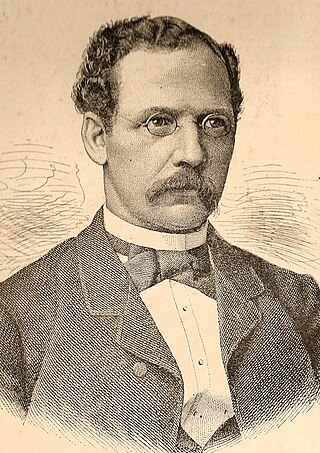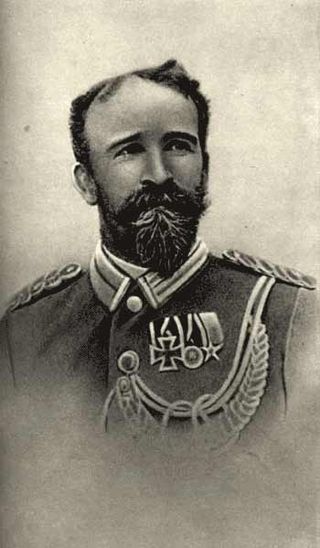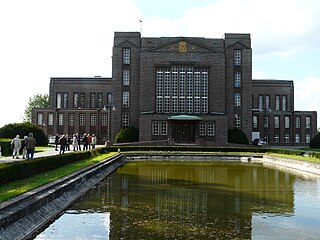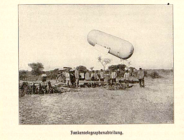
The South West Africa campaign was the conquest and occupation of German South West Africa by forces from the Union of South Africa acting on behalf of the British imperial government at the beginning of the First World War. The South African Prime Minister Louis Botha took the unusual move of directly leading his troops into battle as commander-in-chief, to the frustration of his cabinet.

Lüderitz is a town in the ǁKaras Region of southern Namibia. It lies on one of the least hospitable coasts in Africa. It is a port developed around Robert Harbour and Shark Island.

Franz Adolf Eduard Lüderitz was a German merchant and the founder of German South West Africa, Imperial Germany's first colony. The coastal town of Lüderitz, located in the ǁKaras Region of southern Namibia, is named after him.

TransNamib Holdings Limited, commonly referred to as TransNamib, is a state-owned railway company in Namibia. Organised as a holding company, it provides both rail and road freight services, as well as passenger rail services. Its headquarters are in the country’s capital Windhoek.

Curt Karl Bruno von François was a German geographer, cartographer, Schutztruppe officer and commissioner of the imperial colonial army of the German Empire, particularly in German South West Africa where he was responsible on behalf of Kaiser for the foundation of the city of Windhoek on 18 October 1890 and the harbor of Swakopmund on 4 August 1892.

Georg Wilhelm Alexander Hans Graf von Arco was a German physicist, radio pioneer, and one of the joint founders of the "Society for Wireless Telegraphy" which became the Telefunken company. He was an engineer and the technical director of Telefunken. He was crucial in the development of wireless technology in Europe.

Nauen Transmitter Station in Nauen, Havelland district, Brandenburg, Germany, is the oldest continuously operating radio transmitting installation in the world. Germany's first high power radio transmitter, it was founded on 1 April 1906 by Telefunken corporation and operated as a longwave radiotelegraphy station through World War II, and during World War I became Germany's main link with the outside world when its submarine communications cables were cut. Upgraded with shortwave transmitters in the 1920s it was Germany's most advanced long range radio station, continually upgraded with the latest equipment and serving as an experimental station for Telefunken to test new technology. At the end of World War II, invading Russian troops dismantled and removed the transmitting equipment. During the Cold War it served as the GDR's international shortwave station Radio Berlin International (RBI), and was the East Bloc's second most powerful radio station, disseminating Communist propaganda to other countries. Since German Reunification in 1991 it has been operated by Deutsche Telekom, Germany's state telecommunication service. The original 1920 transmitter building designed by architect Herman Muthesius is still used; it is one of the many remaining buildings designed by that architect that is a protected cultural heritage site.

Vehicle registration plates of Namibia are yellow fluorescent metal plates with imprints in black. The standard version is uniform throughout the country, and carries one of the following forms:

The Battle of Sandfontein was fought between the Union of South Africa on behalf of the British Imperial Government and the German Empire on 26 September 1914 at Sandfontein, during the first stage of the South West Africa Campaign of World War I, and ended in a German victory.

Windhoek railway station is a railway station serving the city of Windhoek, the capital of Namibia. It is an important station in the Namibian rail network, and it is run by TransNamib.

Kranzberg railway station is a railway station in Namibia between the towns of Karibib and Usakos. It is part of the TransNamib Railway. At Kranzberg, the railway line from Windhoek splits; one line continues westwards to Swakopmund and Walvis Bay, the other one continues north-eastwards towards Omaruru and Tsumeb.

German South West Africa was a colony of the German Empire from 1884 until 1915, though Germany did not officially recognise its loss of this territory until the 1919 Treaty of Versailles.

German South West Africa was a German colony in Africa, established in 1884 with the protection of the area around Lüderitz and abandoned during World War I, when the area was taken over by the British.

Grasplatz is a defunct railway station in the south of Namibia on the currently decommissioned Aus–Lüderitz line. It is the place where in 1908 railway worker Zacharias Lewala found the first diamond in German South-West Africa and handed it over to his foreman August Stauch. Stauch's subsequent investigation triggered a diamond rush.

The rail service in Namibia is provided by TransNamib. The Namibian rail network consists of 2,687 km of tracks (2017).

Shark Island or "Death Island" was one of five concentration camps in German South West Africa. It was located on Shark Island off Lüderitz, in the far south-west of the territory which today is Namibia. It was used by the German Empire during the Herero and Namaqua genocide of 1904–08. Between 1,032 and 3,000 Herero and Namaqua men, women, and children died in the camp between March 1905 and its closing in April 1907.

Namibia is a multilingual country in which German is recognised as a national language. While English has been the sole official language of the country since 1990, in many areas of the country, German enjoys official status at a community level. A national variety of German is also known as Namdeutsch.

Parliamentary elections were held in South West Africa on 15 September 1965. The whites-only election saw a victory for the National Party of South West Africa, which won all 18 seats in the Legislative Assembly. From this election onwards, no other party won even a single seat of the Legislative Assembly during the apartheid era.

Parliamentary elections were held in South West Africa on 8 March 1961. The whites-only election saw a victory for the National Party of South West Africa, which won 16 of the 18 seats in the Legislative Assembly, maintaining exactly the number of seats it had won in the previous election. The 1961 polls marked the last time during the apartheid era that any other party won seats.

The Imperial Schutztruppe for German South West Africa was the official name of the military formation that maintained the Imperial German rule in its colony of German South West Africa. The Schutztruppe are held responsible for numerous atrocities in the Herero and Nama uprising in 1904. During World War I, the Schutztruppe was defeated by the military of the Union of South Africa.
![Memorial stone created by lieutenant Brock to remember the "Funkenstation" (radio station) on Farm Aar [de] near Aus Gedenkstein Funkenstation Farm Aar (2015).jpg](http://upload.wikimedia.org/wikipedia/commons/thumb/a/ad/Gedenkstein_Funkenstation_Farm_Aar_%282015%29.jpg/220px-Gedenkstein_Funkenstation_Farm_Aar_%282015%29.jpg)


























